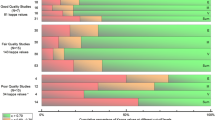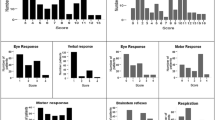Summary
A new scale for assessment of overall responsiveness, the Reaction Level Scale (RLS 85), which has been shown to have better reliability than the Glasgow Coma Scale (GCS), has been tested in four neurosurgical departments regarding inter-observer agreement and coveragei. e. the proportion of patients that could be assessed by the scale. In a carefully designed study 51 observers pairwise performed 164 tests on 88 patients. Reliability was studied by the Kappa method, which is defined as inter-observer agreement corrected for agreement by chance. The inter-observer agreement measured as overall Kappa was good (K=0.69 ±0.05) and there were no significant differences between the departments, professional categories or aetiologies. Regarding the separate RLS 85 levels the Kappa values were above 0.65, except for withdrawing (K=0.51) and flexor responses (K=0.55). There was good inter-observer agreement on coma (K=0.71).
In conclusion, the RLS 85 proved to be easily learnt, it showed full coverage without pseudoscoring, and it was used in a consistent way by doctors, nurses and assistant nurses of four different neurosurgical departments in two Scandinavian countries.
Similar content being viewed by others
References
Abreviated Injury Scale 1985 Revision. American Association for Automotive Medicine, Arlington Heights IL 60005, USA
Bates D, Caronna JJ, Cartlidge NEF, Knill-Jones RP, Levy DE, Shaw DA, Plum F (1977) A prospective study of nontraumatic coma: Methods and Results in 310 patients. Ann Neurol 2: 211–220
van der Berge JH, Schouten HJA, Boomstra S, van Drunen Littel S, Braakman R (1979) Interobserver agreement in assessment of ocular signs in coma. J Neurol Neurosurg Psychiatry 42: 1163–1168
Bishop YMM, Fienberg SE, Holland PW (1975) Discrete multivariate analysis. MIT Press, Cambridge Mass, pp 395–397
Born JD, Albert A, Hans P, Bonnal J (1985) Relative prognostic value of best motor response and brain stem reflexes in patients with severe head injury. Neurosurgery 16: 595–401
Braakman R, Avezaat CJJ, Maas AIR, Roel M, Schouten HJA (1977) Interobserver agreement in the assessment of the motor response of the Glasgow Coma Scale. Clin Neurol Neurosurg 80: 100–106
Braakman R, Gelpke GJ, Habbema JDF, Maas AIR, Minderhoud JM (1980) Systematic selection of prognostic features in patients with severe head injury. Neurosurgery 6: 362–370
Braakman R, Habbema JDF, Gelpke FJ (1982) Comparability of Data. In: Grossman RG, Gildenberg PL (eds) Head injury: basic and clinical aspects. Raven Press, New York, pp 189–194
Bradley JV (1968) Distribution free statistical tests. Prentice-Hall, New York, pp 76–78
Brihaye J, Frowein RA, Lindgren S, Loew F, Stroobrandt G (1978) Report on the Meeting of the W.F.N.S. Neuro-Traumatology Committee, Brussels, 19–23 September 1976. Acta Neurochir (Wien) 40: 181–186
Cohen JA (1960) A coefficient of agreement for nominal scales. Educ Psychol Measurem 20: 37–46
Eisenberg HM (1985) Outcome after head injury: General considerations and neurobehavioral recovery. Part I: General considerations. In: Becker DP, Povlishock JT (eds) Central nervous system trauma status report 1985, NIH, Washington, pp 271–280
Fleiss JL (1971) Measuring nominal scale agreement among many raters. Psychol Bull 76: 378–382
Gennarelli TA, Spielman GM, Langfitt TW, Gildenberg PL, Harrington T, Jane JA, Marshall LF, Miller JD, Pitts LH (1982) Influence of the type of intracranial lesion on outcome from severe head injury. J Neurosurg 56: 26–32
Godfrey K (1985) Comparing the means of several groups. N Engl J Med 313: 1450–1456
Guildford JP (1975) Psychometric Methods. Tata McGraw-Hill edition, Haryana, pp 278–280
Holmgren E, Lindgren S, Starmark J-E, Stålhammar D (1985) Assessment of coma and severity of head injuries in Scandinavian countries. Acta Neurochir (Wien) 78: 73–74
International Classification of Diseases. Manual of the International Statistical Classification of Diseases, Injuries and Causes of Death (1977) World Health Organization, Geneva
Jennett B, Teasdale G (1977) Aspects of coma after severe head injury. Lancet i: 878–881
Jennett B, Teasdale G, Braakman R, Minderhoud J, Heiden J, Kurze T (1979) Prognosis of patients with severe head injury. Neurosurgery 4: 283–289
Langfitt TW (1978) Measuring the outcome from head injuries. J Neurosurg 48: 673–678
Langfitt TW, Gennarelli TA (1982) A holistic view of head injury including a new clinical classification. In: Grossman RG, Gildenberg PL (eds) Head injury: basic and clinical aspects. Raven Press, New York, pp 1–14
Levy DE, Bates D, Caronna JJ, Cartlidge NEF, Knill-Jones RP, Lapinski RH, Singer BH, Shaw DA, Plum F (1981) Prognosis in nontraumatic coma. Ann Intern Med 94: 293–301
Lindsay KW, Teasdale G, Knill-Jones RP (1982) Observer variability in grading patients with subarachnoidal hemorrhage. J Neurosurg 56: 628–633
Lindsay KW, Teasdale GM, Knill-Jones RP (1983) Observer variability in assessing the clinical features of subarachnoid hemorrhage. J Neurosurg 58: 57–62
Lindström S (1986) Experimental animal physiology related to brain stem control of wakefulness. In Lindgren S (ed) Modern concepts in neurotraumatology. Acta Neurochir (Wien) [Suppl] 36: 81–85
Maas AIR, Braakman R, Schouten HJA, Minderhoud JM, van Zomeren AH (1983) Agreement between physicians on assessment of outcome following severe head injury. J Neurosurg 58: 321–325
Marshall LF, Sadler GR, Klauber MR, Bowers SA (1982) Head Injuries: How can we compare outcomes? In: Grossman RG, Gildenberg PL (eds) Head injury: basic and clinical aspects. Raven Press, New York, pp 195–201
Miller JD, Teasdale GM (1985) Clinical trials for assessing treatment for severe head injury. In: Becker DP, Povlishock JT (eds) Central nervous system trauma status report 1985, NIH. Washington, pp 17–32
Plum F (1975) State of consciousness scoring system: Comment. J Neurosurg 43: 251–252
Plum F, Posner JB (1980) Diagnosis of stupor and coma, 3rd edition. FA Davies Company, Philadelphia
Price DJ (1986) Factors restricting the use of coma scales. In: Lindgren S (ed) Modern concepts in neurotraumatology. Acta Neurochir (Wien) [Suppl] 36: 106–111
Price DJ, Marsden AK (1982) A practical coma scale for monitoring head injuries. In: Wilson, Marsden (eds) Care of the acutely ill and injured. J Wiley and Sons, Ltd
Stanczak DE, White III JG, Gouview WD, Moehle KA, Daniel M, Novack T, Long CJ (1984) Assessment of level of consciousness following severe neurological insult. J Neurosurg 60: 955–960
Starmark J-E, Heath A (1987) Severity grading in self-poisoning. Submitted for publication
Starmark J-E, Stålhammar D, Holmgren E (1987) Assessment of responsiveness in acute cerebral disorders. A critical survey of current reporting with special reference to the Glasgow Coma Scale. RLS85. To be published
Starmark J-E, Stålhammar D, Holmgren E, Rosander B (1987) Assessment of responsiveness in acute cerebral disorders. The Glasgow Coma Scale and the Reaction Level Scale (RLS85)—a comparison. To be published
Starmark J-E, Stålhammar D, Holmgren E, Olanders S, Rosander B (1987) Assessment of Responsiveness in Acute Cerebral Disorders. Interobserver Variability in the Glasgow Coma Scale Sum Score. To be published.
Stålhammar D, Starmark J-E (1986) Assessment of responsiveness in head injury patients. In: Lindgren S (ed) Modern concepts of neurotraumatology. Acta Neurochir (Wien) [Suppl] 36: 91–94
Sugiura K, Muraoka K, Chishiki T, Baba M (1983) The Edinburgh—2 Coma Scale: A new scale for assessing impaired consciousness. Neurosurgery 12: 411–415
Teasdale G, Jennett B (1974) Assessment of coma and impaired consciousness. A practical scale. Lancet ii: 81–84
Teasdale G, Jennett B (1976) Assessment and prognosis of coma after head injury. Acta Neurochir (Wien) 34: 45–55
Teasdale G, Knill-Jones R, van der Sande J (1978) Observer variability in assessing impaired consciousness and coma. J Neurol Neurosurg Psychiatry 41: 603–610
Author information
Authors and Affiliations
Rights and permissions
About this article
Cite this article
Stålhammar, D., Starmark, J.E., Holmgren, E. et al. Assessment of responsiveness in acute cerebral disorders. Acta neurochir 90, 73–80 (1988). https://doi.org/10.1007/BF01560558
Issue Date:
DOI: https://doi.org/10.1007/BF01560558




